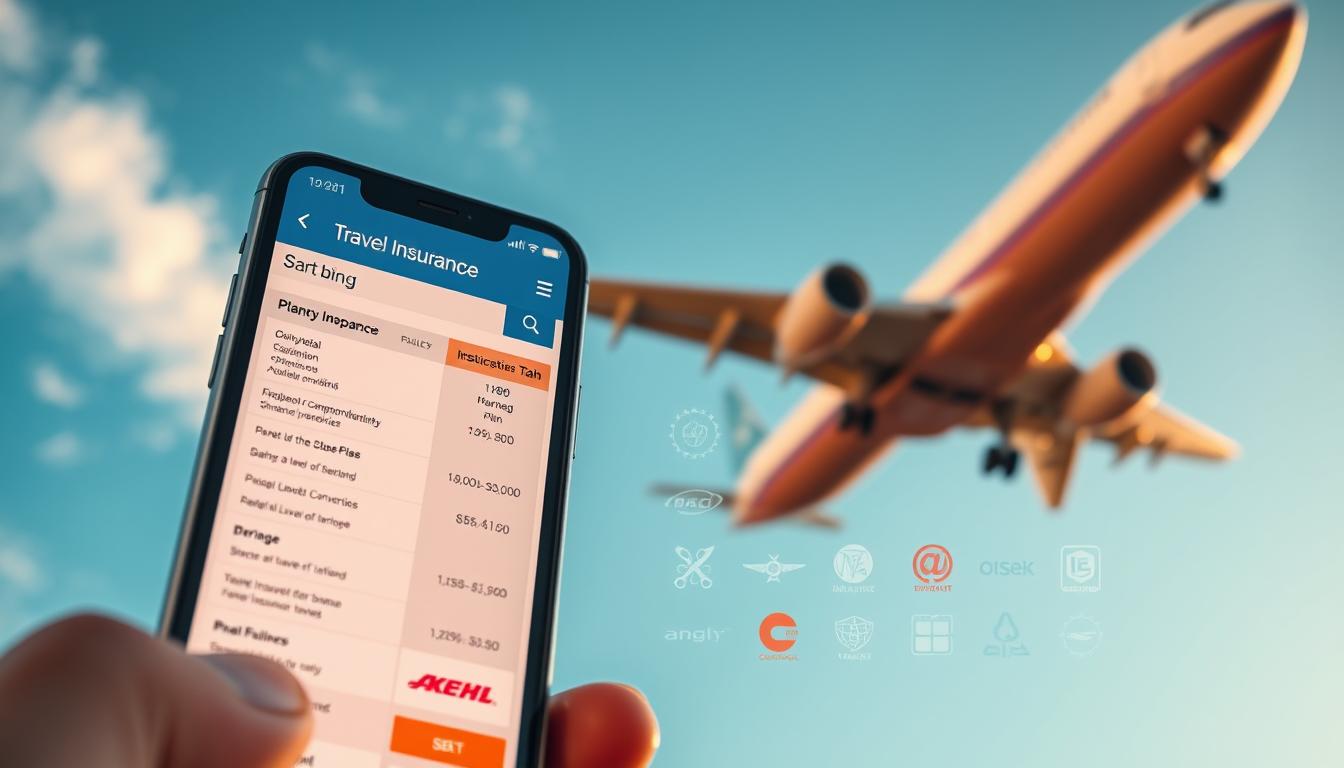Want a simple way to pick protection that fits your trip and budget?
Booking a big trip often means prepaid hotels and nonrefundable tours. That risk makes coverage more than a nice add‑on — it can protect your funds and your plans. In 2023, travelers paid about $403 for comprehensive policies versus $96 for medical‑only plans. A good rule is that comprehensive options often cost roughly 5–10% of the trip price.
In this guide, we give a clear, step‑by‑step framework so you can match plans to your itinerary — from quick getaways to long, multi‑country trips. We’ll point out the benefits, common exclusions, and when a lean medical policy is enough versus when full coverage is worth the spend.
Read on and you’ll gain a practical checklist to find the right limits, avoid duplicate protections, and leave for your next adventure with real peace of mind.
Understand today’s travel risks and why coverage matters
Before you buy a plan, weigh the real risks that could turn a good trip into an expensive one. Start by asking what you cannot get back: deposits, flights, or nonrefundable tours.
When inexpensive trips may not need a policy: Short domestic getaways with refundable bookings often carry low financial exposure. If your hotel and flights are flexible, you might skip extra coverage and rely on card protections.
When prepaid or international travel makes coverage essential: Large deposits, guided tours, and trips abroad raise both financial and medical risk. U.S. plans and Medicare rarely cover medical care overseas. Trip cancellation can reimburse prepaid reservations if you, a family member, or a natural disaster blocks travel.
- Assess refundable vs. nonrefundable costs.
- Match coverage to medical and evacuation risk abroad.
- Consider season, route, and personal health exposure.
| Trip Type | Main Risk | Suggested Coverage |
|---|---|---|
| Weekend with refundable hotels | Low financial loss | None or minimal medical plan |
| Prepaid international holiday | Nonrefundable costs, medical abroad | Comprehensive plan with trip cancellation |
| Milestone trip with deposits | High outlay, delays | Full coverage plus evacuation limits |
Know the core types of travel insurance and what they cover
Know what each policy actually protects before you book—coverage can vary widely.
Comprehensive travel insurance bundles many benefits in one plan. It often includes trip cancellation, interruption, and delay plus emergency medical, medical evacuation, and repatriation. Baggage protection, AD&D, rental car collision, and 24‑hour assistance are usually part of the package.
By contrast, travel medical insurance focuses on health care abroad. It pays urgent care and hospital bills but often excludes routine care and adventure sports unless you add a rider.
Trip cancellation, interruption, and delay
Trip cancellation reimburses prepaid, nonrefundable trip costs for covered reasons like sudden illness or natural disasters. Interruption covers unused portions and extra return costs if you cut a trip short.
Trip delay reimburses lodging and meals after a carrier delay that exceeds the policy’s hour threshold. Check hour limits and per‑day caps.
Emergency medical, evacuation, and repatriation
Emergency medical covers hospital and urgent care overseas. Medical evacuation pays for transport to adequate care, and repatriation brings you home when needed. These limits matter—higher caps mean fewer out‑of‑pocket surprises.
Baggage, AD&D, rental car collision, and assistance
- Baggage: reimbursement for lost, stolen, or damaged items; baggage delay funds essentials after a wait period.
- AD&D: lump-sum benefits for accidental death or severe injuries.
- Rental car collision: repair costs for rental damage—check liability gaps with your personal auto policy.
- 24‑hour assistance: help with medical referrals, emergency cash transfers, and logistics.
| Plan Type | Main Focus | When to Pick |
|---|---|---|
| Comprehensive travel insurance | Cancellation, medical, evacuation, baggage | Prepaid trips, high nonrefundable costs |
| Travel medical insurance | Emergency care and evacuation | Primarily medical concerns, lower cost |
| Adventure add‑on | Covers high‑risk activities | Plans that exclude adventure sports by default |
How much does travel insurance cost right now
A few quick numbers will tell you if a quote is reasonable for your upcoming trip.
Rule of thumb: comprehensive policies usually run about 5–10% of the total trip cost. Use that percent first, then check a daily benchmark to sanity‑check quotes.
Squaremouth users show a directional average of roughly $20.50 per day across policies. In 2023 the typical spend was about $403 for comprehensive plans and $96 for medical‑only plans. That gap shows how much a full bundle adds for cancellation coverage, evacuation, and baggage protection.
- Long trips, older travelers, and higher limits raise premiums.
- Add‑ons like Cancel For Any Reason increase costs but widen flexibility.
- Destination healthcare costs can push prices up even for similar trip cost totals.
| Plan type | Typical cost | When to pick |
|---|---|---|
| Comprehensive | 5–10% of trip cost / ~$403 avg | Prepaid, nonrefundable bookings |
| Medical‑only | Lower, ~$96 avg | Flexible trips needing only health coverage |
| Daily benchmark | $20.50 per day | Quick sanity check for quotes |
Always price at least three insurance plans side‑by‑side with similar limits. If a quote looks unusually low, read exclusions and sub‑limits carefully. Spend should match your financial risk—don’t overpay for cancellation if your bookings are flexible, and don’t under‑insure high‑stakes itineraries.
Key factors that change your premium and coverage
Small changes in trip length or destination can reshape policy cost and scope. Knowing the drivers helps you pick sensible limits without overpaying.
Trip length, cost, and destination healthcare
Longer trips raise premiums because risk accumulates across days. Higher prepaid trip costs also push prices up—insurers price exposure to lost deposits and bookings.
Destinations with high medical costs increase medical and evacuation charges. For remote or expensive countries, raise medical limits and evacuation caps.
Traveler age and pre-existing conditions
Older travelers usually pay more; age is a strong driver of claims frequency. If you have pre-existing conditions, your policy may exclude related claims.
Look for waivers that cover pre-existing conditions if you buy within the plan’s time window after your deposit.
Coverage breadth and optional add‑ons
Higher medical limits, robust evacuation, and generous baggage caps increase premiums. Add‑ons like CFAR or IFAR expand cancellation rights but cost noticeably more.
Consider primary versus secondary benefits—primary simplifies claims but can be pricier. Check look‑back periods, sub‑limits, and inflation protection so coverage matches real costs.
- Only add adventure riders, rental collision, or high delay limits if you will use them.
- Match limits to actual financial exposure—don’t overinsure flexible bookings.
| Factor | Effect on premium | What to check |
|---|---|---|
| Trip length & cost | Higher | Days and total prepaid outlay |
| Destination healthcare | Higher | Local treatment and evacuation costs |
| Age / pre-existing conditions | Higher or excluded | Waiver windows and look‑back rules |
how to compare travel insurance the right way
Begin with a clear priority: money at stake or medical risk abroad. That choice lets you filter quickly and avoid noise.
Set priorities first. Decide whether your main worry is losing large, nonrefundable payments or paying for emergency care overseas. This directs which coverage and riders matter most.
Set your priorities: financial risk vs. medical risk
Write a short list: nonrefundable totals, likely medical needs, and any high‑risk activities. Use that list as your search filter.
Create a side‑by‑side checklist
- Match line items: cancellation, interruption, delay hours, medical, evacuation, baggage, assistance.
- Confirm covered reasons and look‑back periods for pre‑existing conditions.
- Note whether benefits are primary or secondary.
Match limits to nonrefundable costs
Insure what you cannot get back. Don’t buy full cancellation limits for flexible bookings.
Read the policy certificate
Open the certificate and check exclusions, hour thresholds, and documentation rules before purchase.
| Checklist item | What to check | Why it matters | Quick tip |
|---|---|---|---|
| Trip cancellation & interruption | Limits, covered reasons | Protects prepaid losses | Match limits to nonrefundable totals |
| Medical & evacuation | Benefit caps, primary/secondary | Reduces out‑of‑pocket abroad | Choose primary when possible |
| Delay & baggage | Hour triggers, per‑day caps | Avoid surprise shortfalls | Keep receipts and carrier notes |
Shortlist 2–3 plans and pick the one that best matches your risk profile and budget. That’s the simplest way to find right coverage without overpaying.
Use trusted comparison tools and providers
Start on a neutral marketplace that lets you scan many plans without a sales pitch.

Begin with Squaremouth, TravelInsurance.com, or InsureMyTrip. These sites show side‑by‑side filters for medical limits, evacuation caps, delay thresholds, and CFAR. Squaremouth lists plans from 20+ top providers, with 4.1M+ trips insured and 52,000+ reviews (4.92/5). It also offers guaranteed low prices and 24/7 support.
Use filters for destination medical limits and pandemic disclosures. Check verified reviews and whether the marketplace offers claims advocacy or advocacy help during disputes. Save quotes—many waivers require purchases inside a short window after a deposit.
- Pick a neutral marketplace for speed and transparency.
- Use filters that match your needed coverage and limits.
- Read policy certificates from the marketplace before purchase.
| Marketplace | Key features | Trips/Reviews | Best for |
|---|---|---|---|
| Squaremouth | Side‑by‑side filters, 24/7 support, guaranteed pricing | 4.1M+ trips; 52,000+ reviews (4.92/5) | Broad shopper needs; fast price checks |
| TravelInsurance.com | Customer reviews, COVID filters | Wide provider set; user ratings | General shoppers wanting pandemic clarity |
| InsureMyTrip | Claim advocacy, plan education | Large marketplace; user feedback | Those seeking help with claims |
Choosing between plan types for your itinerary
Your trip style—one big holiday, many short breaks, or months abroad—drives the best plan choice. Match the scope of coverage to what you might lose or need overseas.
Single‑trip, annual/multi‑trip, and long‑term policies
Single‑trip plans fit one major vacation with deposits. They balance cancellation, interruption, and medical needs well for big trips.
Annual travel or multi‑trip plans suit frequent short getaways. They often cap trip cancellation amounts—check limits before purchase.
Long‑term or renewable medical‑forward plans help nomads. Verify duration limits and return‑home clauses.
Flight‑only, cruise, group, and adventure sports plans
Flight‑only policies are narrow: delays, lost baggage, and air cancellations. Lean, but limited.
Cruise options raise medical and evacuation caps and cover missed connections at sea.
Group plans simplify signups for weddings or tours and often offer better pricing for many travelers.
Adventure riders add coverage for higher‑risk activities—look for explicit lists and equipment limits.
| Plan type | Best for | Key feature |
|---|---|---|
| Single‑trip | One big trip | Full cancellation & medical |
| Annual | Multiple short trips | Cost per trip savings |
| Cruise / Adventure | Specialty itineraries | Higher medical or activity cover |
Mix and match: a medical base plus riders can beat an all‑in bundle if bookings are flexible. Always confirm state and destination availability—some coverage options aren’t offered in every place.
Dial in smart coverage amounts for medical and evacuation
Set clear dollar floors so medical care won’t surprise you mid‑trip. Choose minimums that match your route and likely medical expenses. Small investments now can avoid large bills later.
Recommended minimums for international trips and cruises
For most international trips, aim for at least $50,000 in emergency medical coverage. If you’re cruising, boost that floor to $100,000—shipboard care and transfers cost more.
For medical evacuation, target at least $250,000 per trip. Air ambulance and long transfers escalate quickly, especially from remote ports or islands.
When remote destinations call for higher limits
Scale limits higher for expeditions, high‑altitude treks, or regions with sparse hospitals. Distance to care and limited local resources raise both medical expenses and evacuation complexity.
- Check per‑incident vs. per‑trip maximums and sub‑limits.
- Verify stabilization, repatriation, and assistance provider approval rules.
- Add riders for adventure activities or maritime evacuation if needed.
- Consider delay protections of $500 per traveler for long disruptions.
| Need | Recommended minimum | Why it matters |
|---|---|---|
| International emergency medical | $50,000 | Covers ER, imaging, short hospital stays abroad |
| Cruise medical | $100,000 | Higher shipboard & transfer costs; limited onboard care |
| Medical evacuation | $250,000 | Air ambulance, complex logistics, long‑distance transfers |
| Trip delay protection | $500 per traveler | Helps with lodging and essentials after long delays |
Pre‑existing conditions, waivers, and Cancel For Any Reason
The fine print around pre‑existing conditions and CFAR matters far more than the headline price.
Many plans exclude claims linked to pre‑existing conditions unless you buy within a time‑sensitive window after your first deposit. Common look‑back periods run 30–90 days; 60 days is typical.
Understand the plan’s definition of “stable.” That term often controls eligibility. If a condition changed during the look‑back, a waiver may not apply.
Purchase rules and what a waiver covers
- Buy quickly: waivers usually require purchase within the plan’s window after initial payment and you must insure the full nonrefundable trip amount.
- Scope: some waivers cover trip cancellation and emergency medical claims, others cover only cancellation—read the certificate.
- Documentation: organize records and provider notes; clear paperwork speeds claims for both waivers and evacuation approvals.
CFAR versus standard covered reasons
Standard covered reasons include illness, injury, natural disasters, and job loss. CFAR expands rights beyond those reasons.
CFAR typically reimburses around 50–75% of trip cost and must be bought within the plan’s window. It does not usually pay 100% like some standard cancellation benefits.
| Feature | Standard covered reasons | CFAR/IFAR |
|---|---|---|
| Flexibility | Limited, listed reasons | Broad, elective cancellations |
| Reimbursement | Up to 100% | Often 50–75% |
| Purchase timing | Varies | Strict, short window after deposit |
State rules and plan availability vary. Check whether CFAR or IFAR is offered where you live and confirm emergency evacuation approvals when pre‑existing conditions exist. If your health is complex, shortlist plans known for generous waivers and responsive assistance.
Leverage existing protections before you buy
Start by inventorying protections you already hold; that may cut what you need to buy. Many premium cards and home policies cover parts of a trip, so a quick check can save money and avoid duplicate coverage.
Credit card benefits: Some cards include trip delay, cancellation, interruption, lost luggage, and rental car collision when you use the card to book. Read the benefit guide—triggers and caps often vary by issuer.
- Confirm hour thresholds (often 6–12 hours) and per‑trip maximums.
- Note whether benefits are primary or secondary—secondary means your own medical plan must pay first.
- Check rental car collision coverage and liability limits for your destination.
Homeowners and renters: Off‑premises personal property coverage can reimburse lost or stolen items. That may let you lower baggage limits in paid plans.
U.S. health plans and Medicare: Most do not cover care abroad. Even if some coverage exists, medical evacuation is usually excluded.
| Source | Typical benefits | Common limits |
|---|---|---|
| Premium credit card | Trip delay, lost luggage, rental collision | Per‑incident caps, 6–12 hour triggers |
| Homeowners/renters | Personal property off‑premises | Deductible applies; item limits |
| U.S. health / Medicare | Limited or no foreign care | Evacuation excluded |
Final tip: If card and home coverage are strong, consider lightweight medical or evacuation plans that fill gaps. Keep benefit guides and proof of purchase handy—claims need clear documentation. Recheck benefits before each trip; terms change year by year.
When travel insurance may be unnecessary
Not every plan is worth buying—sometimes flexibility already protects your trip. If major bookings are refundable and your card offers strong protections, paying for full travel insurance can be redundant.
Flexible bookings and zero nonrefundable costs: If flights and hotels allow free changes, tally what you would actually lose before you buy a plan. Low financial exposure often means you can skip cancellation coverage.
- Rely on flexible fares and hotel cancellation windows when possible.
- Use your premium card benefits for delay, baggage, and some trip losses.
- For short domestic hops with no prepaid tours, consider only a lean medical option or none at all.
| Situation | Main risk | Recommended action |
|---|---|---|
| All bookings refundable | Minimal loss | Skip comprehensive plans |
| Card covers delays/baggage | Limited gaps | Buy medical or evacuation only |
| Some deposits locked | Nonrefundable costs | Consider basic cancellation coverage |
Keep a running tally of at‑risk dollars. If that total stays near zero, skipping extra coverage can be a reasonable, informed choice that still leaves you with peace mind.
Conclusion
Close your planning loop by matching real risks to clear limits. Start with whether your main priority is financial protection or medical resilience, then filter quotes on trusted marketplaces and read the policy certificate before you buy.
Right‑size coverage for nonrefundable costs and destination risk—remote routes call for higher medical and evacuation caps. Watch the timing rules for pre‑existing waivers and CFAR; those windows shape available options.
Use card and home benefits first, fill gaps with focused plans, and pick providers known for quick claims help. Remember the benchmarks: comprehensive often runs about 4–10% of trip cost, with medical/evacuation minimums near $50,000 and $250,000.
With a short checklist for trip cancellation, trip interruption, delay, medical, evacuation, baggage, and assistance, you’ll choose the best travel insurance for your needs—and go with confidence.


